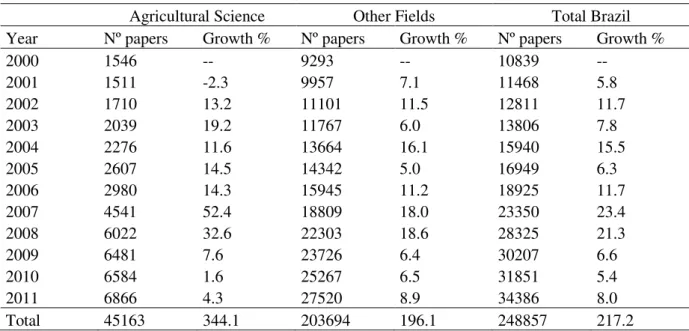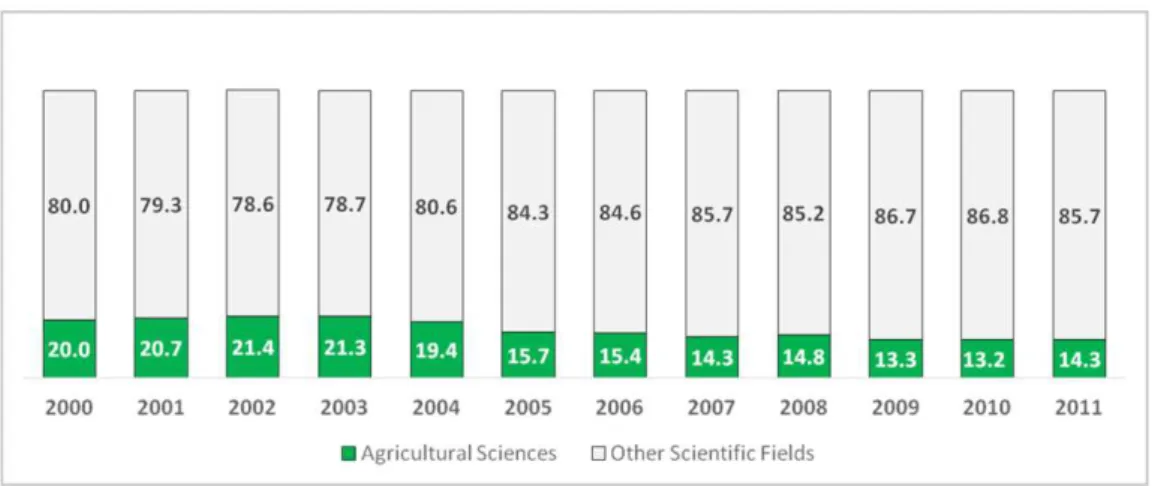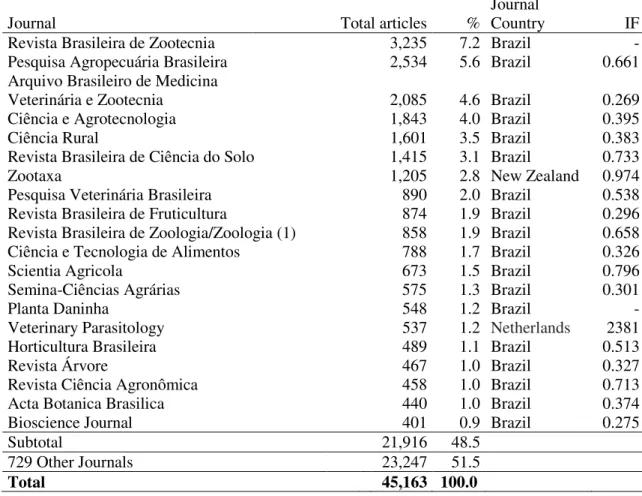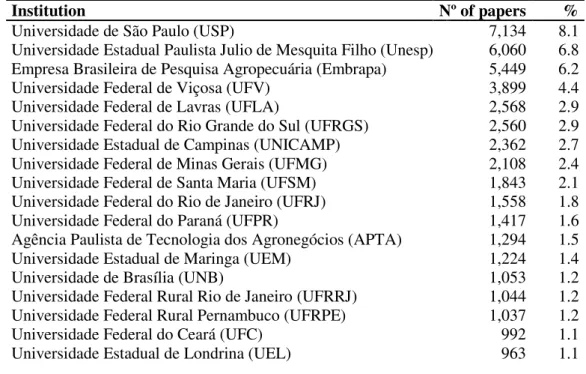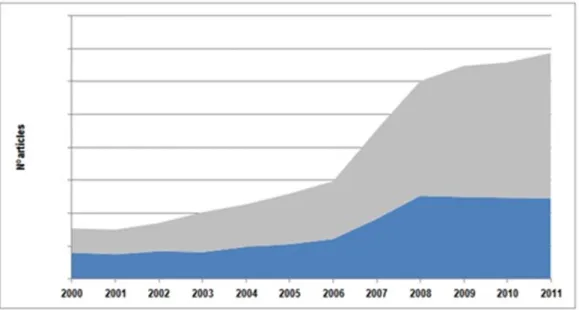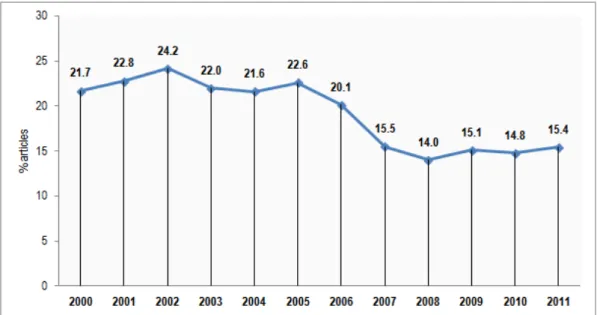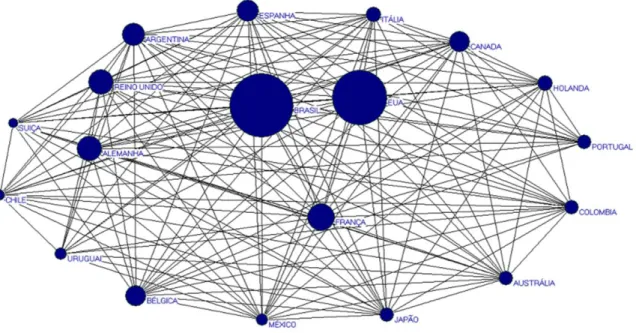Brazilian agricultural research in the Web of
Science: a bibliometric study of scientific output
and collaboration (2000-2011)
Rosely Andrade Vargas
Mestra; Universidade Federal do Rio Grande do Sul; rosely.vargas@telessauders.ufrgs.br
Samile Andréa de Souza Vanz Doutora; Universidade Federal do Rio Grande do Sul;
samilevanz@terra.com.br
Ida Regina Chittó Stumpf
Doutora; Universidade Federal do Rio Grande do Sul; irstumpf@ufrgs.br
Abstract:This paper presents an analysis of the scientific output and
collabora-tion of Brazilian agricultural research in the Web of Science (WoS) during 2000-2011. A total of 45,163 documents were retrieved. Data analysis was con-ducted with the use of the softwares Bibexcel and Pajek. The results indicated that the number of Brazilian articles in the field of agricultural sciences indexed in WoS has increased by 344%; however, the main driver for this growth was the raise in the number of national journals indexed in the database. Although Brazilian articles have been found in 799 journals from 46 countries, 53.5% of the total production was published in national journals with low impact factor. The percentage of articles with multiple authors in the total volume of publica-tions increased from 96.1% in 2000 to 98.4% in 2011. The proportion of articles in collaboration between institutions rose from 47.3%, in 2000, to 64.2%, in 2011. However, there was a decrease in publications with international collabo-ration from 21.7 % in 2000 to 15.4 % in 2011. The most important collaborative relationships were established with the U.S., France and Germany.
Keywords: Brazilian science. Agricultural sciences. Scientific output. Biblio-metrics. Scientific collaboration.
1 Introduction
in the country in the past fifty years – first, with the creation of graduate courses in agricultural sciences and, then, with the establishment of the Empresa Bra-sileira de Pesquisa Agropecuária (Embrapa) – the Brazilian Company of Agri-cultural Research. Embrapa is a public enterprise devoted to provide feasible solutions to agribusiness through generating and transferring knowledge and technology.
Presently, most of the agricultural research developed in Brazil is con-ducted at 42 local branches of Embrapa, 613 graduate courses and over 30 state
research institutes (GEOCAPES, 2013; EMPRESA BRASILEIRA…, 2013).
About 10% of the Brazilian government public expenditure on Research and Development (R&D) are oriented towards agriculture (MINISTÉRIO..., 2013). This is one of the activities that amass the largest volume of governmental re-sources aimed at research (CRUZ; CHAIMOVICH, 2010). The relevance of agricultural research lies in its both economic and social effects: it raises the productivity of agribusiness, promotes exports and creates jobs, thus contrib-uting to the growth of the GDP and the rural development of the country.
Measured in terms of number of indexed articles published, agricultural research stands out as one of the most productive fields within the Brazilian sci-entific output (GLÄNZEL; LETA; THIJS, 2006). It is also one of the fields in which the country has the most significant worldwide representation. Between 2007 and 2011, the articles on agricultural sciences published by Brazilian re-searchers in journals indexed in the Web of Science (WoS) corresponded to 8.8% of the world output (ADAMS; PENDLEBURY; STEMBRIDGE, 2013).
The bulk of articles in this area led Brazil to stand at the 13th position of WoS’
international ranking of scientific output: ahead of countries like the Nether-lands, Russia, Switzerland and Denmark (PACKER, 2011).
Thomson Reuters’ database, as well as a process of change in the journals. B ib-liometric analysis show the impact of such changes in the Brazilian output in agricultural sciences.
2 Methods
The choice of WoS for data collection was based on its tradition and compre-hensiveness, as well as for being internationally used for macro analyses of sci-entific output. We considered also the fact that it includes the names of all au-thors of published works, and information on the institutions and country of origin of the authors as well, thus allowing analyses of collaboration patterns.
Data retrieval was based on keywords selected from a list of knowledge areas and subareas, as defined by the Coordenação de Aperfeiçoamento de Pes-soal de Nível Superior (CAPES), and adapted to the Web of Science Category, which contains 249 terms for the various knowledge areas and subareas. Out of these, we selected 13 terms related to the Brazilian agricultural sciences, inclu-ding agronomy, food and technology, veterinary science and fishery resources. The term search included the WC (Web of Science Category) field coupled with
a CU (country) field, referring to the authors’ country of residence. The term
search used was: CU=(BRAZIL OR BRASIL) AND WC=(Agricultural Econo-mics & Policy OR Agricultural Engineering OR Agriculture, Dairy & Animal Science OR Agriculture, Multidisciplinary OR Agronomy OR Fisheries OR Food Science & Technology OR Forestry OR Horticulture OR Plant Sciences OR Soil Science OR Veterinary Sciences OR Zoology).
Data retrieval was done in January 2012 through the Advanced Search at the Science Citation Index Expanded (SCI-EXPANDED) and at the Social Sciences Citation Index (SSCI). It was limited to the period 2000-2011 and to scientific articles. A total of 45,163 articles with at least one Brazilian address in the field Author Address were retrieved. The softwares Bibexcel, Excel 2007 and Pajek were used for data and network analysis.
an article for each of the several participants (LUUKKONEN; PERSSON; SI-VERTSEN, 1992; BORDONS; GOMEZ, 2000). Therefore, for an article au-thored, for instance, by five different institutions, the value of one article was attributed to each institution. The same procedure was followed for counting articles of distinct countries.
3 Results and discussion
Between 2000 and 2011, Brazilian publications in agricultural sciences indexed in WoS, grew by 344.1% (from 1,546 items to 6,866 items) (Table 1). The greatest growth rates were observed in 2003 (19.2%), 2007 (52.4%) and 2008 (32.6%). The 344.1% growth was higher than the increase of 217.2% in the number of publications in Brazil, considering all areas of knowledge in WoS.
Table 1 - Growth in the number of Brazilian papers per year in agricultural sciences in WoS 2000-2011
Agricultural Science Other Fields Total Brazil Year Nº papers Growth % Nº papers Growth % Nº papers Growth %
2000 1546 -- 9293 -- 10839
--2001 1511 -2.3 9957 7.1 11468 5.8
2002 1710 13.2 11101 11.5 12811 11.7
2003 2039 19.2 11767 6.0 13806 7.8
2004 2276 11.6 13664 16.1 15940 15.5
2005 2607 14.5 14342 5.0 16949 6.3
2006 2980 14.3 15945 11.2 18925 11.7
2007 4541 52.4 18809 18.0 23350 23.4
2008 6022 32.6 22303 18.6 28325 21.3
2009 6481 7.6 23726 6.4 30207 6.6
2010 6584 1.6 25267 6.5 31851 5.4
2011 6866 4.3 27520 8.9 34386 8.0
Total 45163 344.1 203694 196.1 248857 217.2
Source: research data.
The collection of Brazilian journals indexed in WoS accounted to only 17 titles in 2000 (TARGINO; GARCIA, 2000). In 2010, the collection had ex-panded to 132 titles, an increase of 676.5% brought about by the process of
“globalization” of the database (TESTA, 2011). In what concerns agricultural
sciences, the expansion amounted to 462.5%. At the beginning of the decade, WoS indexed eight Brazilian journals in the category Agriculture, Biology & Environmental Sciences (ABES). In 2010, there were 45 titles in this category.
The indexation in that database seems to have encouraged changes in the main Brazilian journals in the area of agricultural sciences. Following indexa-tion, ten journals widely used for scholarly publishing in the area either reduced periodicity or started to publish special issues. The increase in the number of issues published annually by these journals has provided Brazilian researchers with further publishing space and helped to enhance the number of articles from Brazil indexed in WoS (VARGAS; VANZ; STUMPF, 2014).
As to graduate programs in agricultural sciences in the country, their number grew 96.5%, from 172 in 2000 to 338 in 2011. In this same period, the annual number of PhDs and Masters graduates in the country increased by 171% and 124%, respectively (GEOCAPES, 2013). In Brazil, research activities are developed mainly within public universities and research institutes (CRUZ; CHAIMOVICH, 2010). Thus, according to Meis, Arruda and Guimarães (2007),
“there is a linear correlation” between the number of PhD graduates and the
number of articles published in WoS.
Figure 1 - Percentage of publications on agricultural sciences in the total Brazilian scientific
output indexed in WoS, 2000-2011
Source: research data.
The growth in the number of articles by Brazilian authors in WoS’ cat e-gory of agricultural sciences follows the trends observed in previous studies (LETA; THIJS; GLÄNZEL, 2013; LYRA; GUIMARÃES, 2007). Since the 1990s, this scientific field stands as one of the most productive in the country in terms of papers indexed in WoS (GLÄNZEL; LETA; THIJS, 2006). In areas such as agronomy, veterinary science, microbiology, and sciences of plants and animals, it is also observed a predominance of articles originated in Brazil in the whole world output (ADAMS; KING, 2009; CRUZ; CHAIMOVICH, 2010).
The data collected by the present study show that between 2000 and 2011 most of the Brazilian scientific output in the area of agricultural sciences was published in Brazilian journals. Although articles by Brazilian authors in this area have been found in 799 journals published in 46 distinct countries, 24,180 articles (53.5%) were published in Portuguese, in national journals, with limited impact factor and, therefore, lower visibility.
Among the twenty most used journals to publish Brazilian papers, which together have published 21,916 (48.5%) articles, only two are edited outside Brazil: Zootaxa, from New Zealand, and Veterinary Parasitology, from the
institu-tions. Two of the journals listed in Table 2 do not appear in the JCR Science
Edition 2012. Thus, their impact factor was not presented, they are: Revista
Bra-sileira de Zootecnia, published by the Sociedade Brasileira de Zootecnia and
which amassed most of the articles, and Planta Daninha, published by the
So-ciedade Brasileira da Ciência das Plantas Daninhas. Both have been excluded
from JCR “[...] because they presented atypical citation standards which lead to
misrepresentation in their impact factors [...]” (JOURNAL CITATION
RE-PORTS, 2012). Nevertheless, both journals remain indexed in WoS.
Table 2 - Journals with the largest number of Brazilian papers in agricultural sciences in WoS
2000-2011
Journal Total articles %
Journal
Country IF
Revista Brasileira de Zootecnia 3,235 7.2 Brazil -Pesquisa Agropecuária Brasileira 2,534 5.6 Brazil 0.661 Arquivo Brasileiro de Medicina
Veterinária e Zootecnia 2,085 4.6 Brazil 0.269 Ciência e Agrotecnologia 1,843 4.0 Brazil 0.395
Ciência Rural 1,601 3.5 Brazil 0.383
Revista Brasileira de Ciência do Solo 1,415 3.1 Brazil 0.733
Zootaxa 1,205 2.8 New Zealand 0.974
Pesquisa Veterinária Brasileira 890 2.0 Brazil 0.538 Revista Brasileira de Fruticultura 874 1.9 Brazil 0.296 Revista Brasileira de Zoologia/Zoologia (1) 858 1.9 Brazil 0.658 Ciência e Tecnologia de Alimentos 788 1.7 Brazil 0.326
Scientia Agricola 673 1.5 Brazil 0.796
Semina-Ciências Agrárias 575 1.3 Brazil 0.301
Planta Daninha 548 1.2 Brazil
-Veterinary Parasitology 537 1.2 Netherlands 2381 Horticultura Brasileira 489 1.1 Brazil 0.513
Revista Árvore 467 1.0 Brazil 0.327
Revista Ciência Agronômica 458 1.0 Brazil 0.713 Acta Botanica Brasilica 440 1.0 Brazil 0.374
Bioscience Journal 401 0.9 Brazil 0.275
Subtotal 21,916 48.5
729 Other Journals 23,247 51.5
Total 45,163 100.0
(1)Since its foundation in 1982, were published under the name Revista Brasileira de Zoologia. With the goal of broadening its international visibility, starting in 2009, it began to be called Zoologia while keeping the original volume and issue numbering.
Concentrating output in Brazilian journals had impact on the languages most used for publications in the researched area. Articles written in English accounted to 25,730 (57.0%); papers in Portuguese totaled 18,964 (42.0%). The use of other languages was restricted to only 469 papers (1.0%). The predomi-nance of English can be explained by both the international prominence this language assigns to publications (MEADOWS, 1999) and the source chosen for this research, which gathers mainly journals edited in English in the United Sta-tes, England and Netherlands (VAN LEEUWEN et al., 2001).
English was the main language of publication between 2000 and 2007. In 2008, the percentage of articles written in Portuguese exceeded that of papers in En-glish due to the entry of a large number of Brazilian journals in WoS. In 2010 English featured again as the preferred language (Figure 2).
Figure 2 - Percentage of Brazilian papers in agricultural sciences by language indexed in WoS 2000-2011
Source: research data.
This custom is also observed in other knowledge areas. Meneghini and Packer (2007) estimate that about 60% of the 50,000 papers published annually by re-searches from Brazil are written in Portuguese and aimed at national journals, what ends up reducing visibility of the Brazilian scientific output.
Among the documents analyzed, we identified 5,910 Brazilian and for-eign organizations to which the authors are connected. However, a small group of 18 organizations, all of them constituting public institutions, concentrated 50.3% of the whole collection of papers (Table 3). Among the most productive institutions there are two public enterprises devoted to research: Embrapa, which directs the national system of agricultural research and has branches virtually all over the country; and APTA, a public enterprise set up by the São Paulo State government and which congregates traditional institutes such as the Instituto Agronômico de Campinas (Agronomic Institute of Campinas), created in the 19th century. All the other positions in the ranking of the most productive insti-tutions are occupied by public universities, mainly Universidade de São Paulo (USP) and Universidade Estadual Paulista Julio de Mesquita Filho (UNESP), both of which in the past decades have accounted for a major part of the Brazili-an publications indexed in WoS (VELLOSO; LANNES; MEIS, 2004).
Table 3 - Institutions with major output in agricultural sciences in WoS 2000-2011
Institution Nº of papers %
Universidade de São Paulo (USP) 7,134 8.1 Universidade Estadual Paulista Julio de Mesquita Filho (Unesp) 6,060 6.8 Empresa Brasileira de Pesquisa Agropecuária (Embrapa) 5,449 6.2 Universidade Federal de Viçosa (UFV) 3,899 4.4 Universidade Federal de Lavras (UFLA) 2,568 2.9 Universidade Federal do Rio Grande do Sul (UFRGS) 2,560 2.9 Universidade Estadual de Campinas (UNICAMP) 2,362 2.7 Universidade Federal de Minas Gerais (UFMG) 2,108 2.4 Universidade Federal de Santa Maria (UFSM) 1,843 2.1 Universidade Federal do Rio de Janeiro (UFRJ) 1,558 1.8 Universidade Federal do Paraná (UFPR) 1,417 1.6 Agência Paulista de Tecnologia dos Agronegócios (APTA) 1,294 1.5 Universidade Estadual de Maringa (UEM) 1,224 1.4
Universidade de Brasília (UNB) 1,053 1.2
Source: research data.
Scientific collaboration, examined through coauthorship of the publica-tions extracted from WoS, proved to be high among researchers: 44,141 papers (97.7%) involved multiple authorship. The average number of authors per arti-cle, which was 4.1 in 2000, rose to 5.0 in 2011. This can be related to the expan-sion of graduate courses. In recent years there was an increase in the number of graduate students and research groups in the universities, and the academics, who comprise the majority of researchers in the country, have written more pa-pers with their advised graduate students (VANZ; STUMPF, 2012).
Another likely contributing factor to the increase in coauthorship is the criteria for evaluating graduate programs in Brazil. The system, which was set up by CAPES in the end of the 1990s, includes quantitative performance indica-tors, such as the number of papers published annually. Jointly produced papers help researchers to expand their scientific output (LEITE; LETA; MUGNAINI, 2011).
Table 4- Evolution of collaboration between agricultural sciences researchers 2000-2011
Year 2000 2001 2002 2003 2004 2005 2006 2007 2008 2009 2010 2011 Coauthored
papers 1486 1464 1650 2000 2200 2528 2885 4430 5881 6373 6486 6758 Total n.of papers 1546 1511 1710 2039 2276 2607 2980 4541 6022 6481 6584 6866 % coauthored/total 96.1 96.9 96.5 98.1 96.7 96.9 96.8 97.5 97.6 98.3 98.5 98.4
Source: research data.
Scientific collaboration between distinct institutions had a significant increment in the period 2000-2011. The number of papers involving interinstitu-tional coauthorship, including Brazilian and foreign institutions, rose 501.9% - from 732 articles in 2000 to 4,406 in 2011. Thus, the proportion of scientific
Subtotal for the 18 institutions 44,565 50.3 Contributions from the other 5,892 institutions 43,995 49.7
Figure 3- Number of Brazilian articles in agricultural sciences in WoS with and without
inter-institutional collaboration, 2000-2011
Source: research data.
The analyses confirmed a tendency on the part of Brazilian scientific production towards increasing interinstitutional collaboration. In the past two decades, public policies were implemented aiming to promote the creation of cooperative networks between universities, research institutes and other organi-zations. The funding agencies that award grants to universities and research ins-titutes have also encouraged partnerships (MENEGHINI, 1996; LETA; CHAIMOVICH, 2002).
Having research centers in almost all states of the country, Embrapa pre-sents the highest number of coauthored articles (3,405). The enterprise appa-rently plays a role of gatekeeper, connecting the various organizations. The strongest collaboration links established by Embrapa – in terms of coauthored articles – involve USP, Universidade Federal de Viçosa (UFV), UNESP and Universidade Federal de Lavras (UFLA). These are the four Brazilian universi-ties that present the greatest number of graduate programs in the field of agricul-tural sciences.
USP, in turn, has strongest connections with UNESP. Together these two universities published 823 articles in agricultural sciences indexed in WoS bet-ween 2000 and 2011. Embrapa, APTA and UNICAMP follow immediately as main partners. As to UNESP, besides USP, its most intensive cooperative rela-tions are established with Embrapa, APTA, and Universidade Estadual de Cam-pinas (UNICAMP).
The high rates of collaboration between institutions in the State of São Paulo is a result of public policies that promote collaborative networks by fun-ding projects that involve research groups of distinct universities and institutes in both the state and the country. This is the case, for instance, of technological innovation programs as Biota, Cepid, ConSITtec and Genoma (FUNDAÇÃO DE AMPARO..., 2005).
The collaborative links between Universidade Federal do Rio Grande do Sul (UFRGS) and Universidade Federal de Santa Maria (UFSM) in agricultural sciences resulted in 243 coauthored articles indexed in WoS between 2000 and 2011. These two universities of the State of Rio Grande do Sul (RS) have signif-icant partnership with Embrapa, which has four units in RS – Wheat, Grape and Wine, Livestock-South and Temperate Climate – and also with two universities in the State of São Paulo – USP and UNESP. Among other collaborative activi-ties, UFRGS, UFSM and Embrapa, together with other institutions in RS, such as Universidade de Passo Fundo (UPF) and Emater, develop researches on soy-bean pest control (EMPRESA BRASILEIRA..., 2013).
(UFPR) and Universidade Estadual de Maringá (UEM) with regard to agricul-tural research. Although both universities keep important connections with UNESP, USP and Embrapa, the number of articles in the area coauthored by the two institutions from 2000 to 2011 was relatively small: 41 papers, according to the coauthorship criteria. Conversely, the partnership between UEM and Uni-versidade Estadual de Londrina (UEL), both state universities, resulted in about fifty coauthored papers.
In the Federal District (FD), the strong relationship between Univer-sidade de Brasília (UNB) and Embrapa, expressed in 248 coauthored articles, probably results from the nine units of the agricultural research enterprise con-centrated in the FD: Cerrados, Vegetables, Plant Genetic Resources and Bio-technology, Agroenergy, Coffee, Technological Information, Products and Mar-ket, Studies and Training, and Vegetable Quarantine (EMPRESA
BRASILEI-RA…, 2013).
The Universidade Federal Rural de Pernambuco (UFRPE), which shares 422 articles with other institutions of the broad national network of agricultural sciences, holds relationships mainly with Embrapa, which has a research unit in the semi-arid region of the State of Pernambuco, USP, UFV and UNESP. As to the relationships maintained by Universidade Federal do Ceará (UFC), the clos-est ones are with Embrapa, UFV and USP.
In Rio de Janeiro, both the Universidade Federal Rural do Rio de Janeiro (UFRRJ) and Universidade Federal do Rio de Janeiro (UFRJ) are connected
Regarding international collaboration, a regression was observed. Among the 45,163 articles analyzed, there were 7,784 papers (17,2% of the to-tal) coauthored by Brazilian scientists and colleagues in foreign countries. The number of 336 publications involving international collaboration in 2000 rose to 1,060 papers in 2011. In percentage terms, however, this kind of scientific col-laboration decreased. In 2000, 21.7% of Brazilian agricultural sciences papers indexed in WoS involved international collaboration. In 2011, this percentage dropped to 15.4% (Figure 4).
Figure 4- Percentage of Brazilian papers in agricultural sciences involving international
collab-oration indexed in WoS, 2000-2011
Source: research data.
The greatest rate of scientific international collaboration was registered in 2002 (24.2%), when the Conselho Nacional de Desenvolvimento Científico e Tecnológico (CNPq) raised the number of post doctoral scholarships (CNPq, 2013). The lowest rate (14.0%) was observed in 2008, when there was a signifi-cant increase in the number of Brazilian journals indexed in WoS, as seen in figure 4.
educa-tion in Brazil, the decrease in the number of scholarships for studies abroad and the increase of S&T investments in the country are some of the likely causes of
such reduction (VIOTTI; MACEDO, 2003; FUNDAÇÃO DE AMPARO…,
2005). The recent growth in the collection of Brazilian periodicals in the databa-se may have intensified such tendency. While contributing to raidataba-se the number of national articles in WoS, this growth led to the concentration of articles in Brazilian journals, edited mainly in Portuguese, and having lower international visibility (LETA, 2012).
By analyzing the collaboration networks of Brazilian science, between 2004 and 2006, using WoS as source, Vanz and Stumpf (2012) observed a per-centual decrease of international collaboration in the publications of the country, both in the agricultural sciences and in other fields. Science development in Brazil takes a path opposed to that of science worldwide, in which international collaboration increases at a faster pace than the collaboration between institu-tions of a same country. Similarly, by researching the worldwide scientific out-put in the field of Agronomy, indexed in WoS between 1997 and 2011, Cañas-Guerrero et al. (2013) observed a high growth in Brazilian publications, espe-cially at the end of the 2000s. However, according to these authors, the output was concentrated in Brazilian journals and presented low levels of international collaboration.
The analyzed Brazilian articles involving international coauthorship re-vealed cooperative relationships with 128 countries of America, Europe, Asia, Africa and Oceania. Within these publications, 61.4% involved two countries, and for 22.8% three countries took part. Articles comprising coauthorship of four and more countries accounted for the remaining 15.8%.
papers, 6.2%). In South America, the most significant relationships were esta-blished with Argentina (514 papers, 6.6%) and Colombia (200 papers, 2.5%). It is also worth mentioning the collaborations with Australia (204 papers, 2.6%) and Japan (191 papers, 2.4%).
Figure 5-Brazil’s main partner countries in agricultural sciences coauthored publications i
n-dexed in WoS, 2000-2011
Source: research data.
Agronomique pour le Développement (Cirad) of France, and also with
universi-ties of the USA and Europe, such as the University of Florida.
4 Conclusion
The limited number of publications produced through international collaboration can be pointed out as the weakness of Brazilian scientific output in the area of agricultural sciences indexed in WoS between 2000 and 2011. As previously mentioned, since the 1990s the scientific collaboration of Brazil with other countries, measured in terms of internationally coauthored papers indexed in WoS, has been decreasing in several science fields. Both the expansion and con-solidation of graduate programs and the increased investments of the country in science and technology can be pointed as catalysts for this downfall.
On the other hand, the significant growth in the number of Brazilian arti-cles and equally of artiarti-cles produced in coauthorship both between researchers and between institutions throughout Brazil stands out as a strength. These ad-vances happened within a context characterized by the expansion of graduate courses in the area, by the increasing numbers of Doctors and Masters graduated from these courses and by the increase in scientific output. Furthermore, a pro-cess of publishing improvement was observed among the Brazilian scientific journals recently added to WoS. Many journals increased the number of issues published each year following their entry in the database. Therewith, researchers in the country have gained further space for publishing their works.
References
ADAMS, J.; PENDLEBURY, D.; STEMBRIDGE, B. Building bricks. Exploring the
global research and innovation impact of Brazil, Russia, India, China and South
ADAMS, J; KING, C. Global research report: Brazil. Research and collaboration in
the new geography of science. Leeds: Thomson Reuters,2009.
ARVANITIS, Rigas; CHATELIN, Yvon. Bibliometrics of tropical soil sciences: Some
reflections and orientations. In: McDONALD, Peter. The literature of soil science.
Ithaca: Cornell University, 1984. p. 73-94.
BORDONS, María; GÓMEZ, Isabel. Collaboration networkd in science. In: CRONIN,
Blaize; ATKINS, Helen Barsky (Eds.). The Web of Knowledge: a festschrift in honor
of Eugene Garfield. New Jersey: ASIS, 2000. p. 197-214.
CAÑAS-GUERRERO, I. et al. Bibliometric analysis of research activity in the
“Agronomy” category from the Web of Science, 1997-2011. European Journal of
Agronomy, Amsterdam, n. 50, p. 19-28, 2013.
CRUZ, C. H. B.; CHAIMOVICH, H. In: UNITED NATIONS Educational, Scientific
and Cultural Organization. Unesco science report 2010: the current status of science
around the world. Paris: Unesco, 2010. p. 103-122
EMPRESA BRASILEIRA de Pesquisa Agropecuária. [Portal Embrapa]. 2013.
Dis-ponível em: <https://www.embrapa.br/>. Acesso em: 2 jan. 2013.
FUNDAÇÃO DE AMPARO à Pesquisa do Estado de São Paulo. Indicadores de
Ci-ência, Tecnologia e Inovação em São Paulo 2010. São Paulo: FAPESP, 2011.
Dispo-nível em: <http://www.fapesp.br/6479>. Acesso em: 2 jan. 2013.
FUNDAÇÃO DE AMPARO à Pesquisa do Estado de São Paulo. Indicadores de
ciên-cia, tecnologia e inovação em São Paulo 2004. São Paulo: FAPESP, 2005. Disponível
em: <http://www.fapesp.br/2060>. Acesso em: 2 jan. 2013.
GEOCAPES. Dados estatísticos. 2013. Disponível em:
GLÄNZEL, W.; LETA, J.; THIJS, B. Science in Brazil. Part 1: a macro-level
compara-tive study. Scientometrics, Amsterdam, v. 67, n.1, p. 67-86, 2006.
JOURNAL CITATION REPORTS. 2012 JCR Science Edition. [S.l.]: Thomson
Reu-ters, c2013.
KATZ, J. Sylvan; MARTIN, Ben R. What is research collaboration? Research Policy,
Amsterdam, v. 26, n. 1, p. 1-18, march 1997.
LEITE, P.; LETA, J.; MUGNAINI, R. A new indicator for international visibility:
ex-ploring Brazilian scientific community. Scientometrics, Amsterdam, v. 88, n. 1, p.
311-319, 2011.
LETA, J. Brazilian growth in the mainstream science: the role of human resources and
national journals. Journal of Scientometric Research, Mumbai, n. 1, p. 44-52, 2012.
LETA, Jacqueline; CHAIMOVICH, Hernan. Recognition and international
collabora-tion: the Brazilian case. Scientometrics, Amsterdam, v. 53, n. 3, p. 325-335, 2002.
LETA, Jacqueline; THIJS, Bart; GLÄNZEL, Wolfgang. A macro-level study of science in Brazil: seven years later. Encontros Bibli, Florianópolis, v. 18, n. 36, p. 51-66, jan./
abr., 2013.
LIMA, Ricardo Arcanjo de; VELHO, Lea Maria Leme Strini; FARIA, Leandro Inno-centini Lopes de. Análise bibliométrica da atividade científica da Embrapa Solos
(1975-2009). Boletim de Pesquisa e Desenvolvimento, Rio de Janeiro, v. 153, p. 9-26, 2010.
Disponível em:<
http://ainfo.cnptia.embrapa.br/digital/bitstream/item/33162/1/Bol-PD-153.pdf >. Acesso em: 08 out. 2015.
LUUKKONEN, Terttu; PERSSON, Olle; SIVERTSEN, Gunnar. Understanding
pat-terns of international scientific collaboration. Science, Technology & Human Values,
Thousand Oaks, v. 17, n.1, winter 1992, p. 101-126.
LYRA, Tania Maria de Paula; GUIMARÃES, Jorge Almeida. Produção Científica
Planejamen-to e Políticas Públicas, Brasília, v. 30, p. 5-15, 2007. Disponível em:
<www.equalis.com.br/biblioteca_online/download_pdf.php?artigo=28>. Acesso em: 20
jun. 2012.
MEADOWS, J. Comunicação científica. Brasília: Briquet de Lemos, 1999.
MEIS, L.; ARRUDA, A.P.; GUIMARÃES, J. The impact of science in Brazil. IUBMB
Life, London, n. 59, p. 227-34, 2007.
MENEGHINI, R. The key role of collaborative work in the growth of Brazilian science
in the last ten years. Scientometrics, Amsterdam, v. 35, n. 3, p. 367-373, 1996.
MENEGHINI, R.; PACKER, A. L. Is there science beyond English? Initiatives to in-crease the quality and visibility of non-English publications might help to break down
language barriers in scientific communication. EMBO Reports, Heidelberg, n. 8, p.
112-116, 2007.
MINISTÉRIO da Ciência e Tecnologia. Indicadores nacionais. Disponível em:
<http://www.mct.gov.br/index.php/content/view/740.html?execview=>. Acesso em: 1 maio 2014.
PACKER, Abel L. Os periódicos brasileiros e a comunicação da pesquisa naci-onal. Revista USP, São Paulo, v. 89, p. 24-61, 2011.
TARGINO, M.G., GARCIA, J.C.R. Ciência brasileira na base de dados do Institute for
Scientific Information (ISI). Ciência da Informação, Brasília, n. 29, p. 103-17, 2000.
TESTA, J. The globalization of Web of Science, 2005-2010. Philadelphia: Thomson
Reuters,2011. Disponível em: <http://wokinfo.com/media/pdf/globalwos-essay.pdf>.
Acesso em: 14 jul. 2012.
VAN LEEUWEN, T. N. et al. Language biases in the coverage of the Science Citation Index and its consequences for international comparisons of national research
VANZ, S. A. S.; STUMPF, I. R. C. Scientific output indicators and scientific
collabora-tion network mapping in Brazil. Collnet Journal of Scientometrics and Information
Management, New Delhi, n. 6, p. 1-20, 2012.
VARGAS, R. A.; VANZ, S. A. A; STUMPF, I. R.C. The role of National journals on
the rise in Brazilian Agricultural Science Publications in Web of Science. Journal of
Scientometric Research, Mumbai, v. 3, n. 1, p. 28-36, 2014.
VELHO, L. M. The 'meaning' of citation in the context of a scientifically peripheral
country. Scientometrics, Amsterdam, v. 9, n. 1-2, p. 71-89, 1986.
VELLOSO, A.; LANNES, D.; MEIS, L. Concentration of science in Brazilian
gov-ernamental universities. Scientometrics, Amsterdam, v. 61, n. 2, p. 207-220, 2004.
VIOTTI, E. B.; MACEDO, M. Indicadores de Ciência, Tecnologia e Inovação no
Brasil. Campinas: UNICAMP, 2003.
A pesquisa brasileira em Ciências Agrárias na Web of Science:
estudo bibliométrico da produção científica e colaboração
(2000-2011)
de baixo fator de impacto. A percentagem de artigos com vários autores no vo-lume total de publicações aumentou de 96,1% em 2000 para 98,4%, em 2011. A proporção de artigos em colaboração entre as instituições aumentou de 47,3%, em 2000, para 64,2%, em 2011. No entanto houve uma diminuição da porcenta-gem de publicações com colaboração internacional de 21,7% em 2000 para 15,4% em 2011. As relações de colaboração mais importantes foram estabeleci-dos com os EUA, a França e a Alemanha.
Palavras-chave: Ciência brasileira. Ciências Agrárias. Bibliometria. Produção científica. Colaboração científica.
Agradecimentos
Authors thank the funding from CAPES and CNPq for the development of this research.
